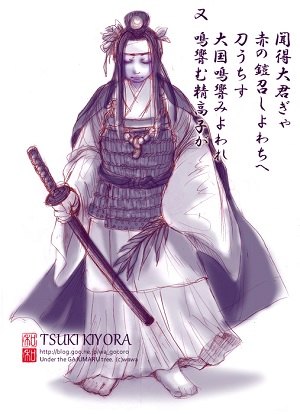In former times, a bell tower and a western guard house once existed in the Kikoe-Ōgimi Udun. In recent years [in 1780] they were abolished. In this year now, by order of Sashiki Aji Ganashi 佐敷按司加那志 (title of the queen of Ryūkyū), they have both been rebuilt.
The Kikoe-Ōgimi Udun 聞得大君御殿 is pronounced Chifijin Udun in the Okinawan pronunciation. It was the sanctuary and living site of the Kikoe-Ōgimi-ganashi (Chifijin-ganashi 聞得大君加那志), the supreme female deity-official of the Ryūkyū Kingdom.
The organization of female deity-official was established during the era of King Shō Shin 尚真王 (rg. 1477–1526). The Kikoe-Ōgimi in her role as a “Sister Goddess” (Onari-gami おなりがみ) was the supreme protector of the king and served in prayers for his longevity, for the prosperity of the country, for huge harvests, for safe sailing voyages and the like.
This organization of holy women, which were explicitly official posts within the royal government organization of the kingdom, is often but must not be confused with the practice of religuous mediums called yuta.

Modern adaption of the Kikoe-Ogimi in armor and with sword, from http://blog.goo.ne.jp/wa_gocoro/e/988da08d094553a532b95a7bbe570694
The first generation Kikoe-Ōgimi was King Shō Shin’s sister Gessei 月清. Since that time either the royal princess or the queen mother served in this office, which continued for 15 generations until the establishment of Okinawa Prefecture in 1879.
If there was one belief that Satsuma tried to curb than it was that of these holy women. Prior to the Satsuma invasion of 1609, the Kikoe-Ōgimi would perform prayers for victory in battle and it had been conluded by historians that she wore armor and treasured swords when she did so at the front court of Shuri castle. This happened, for example, prior to the subjugation of Yaeyama in 1500, and also prior to the 1609 Satsuma invasion. In the latter case, however, to no avail.
The location of the Kikoe-Ōgimi Udun was confirmed on an old early 18th century map of Shuri. According to it, this residence was situated in Teshiraji. At that time the site was surrounded by a stone wall and covered an area of about 6600 square meters.
Following the establishment of Okinawa Prefecture, the shrine of the Kikoe-Ōgimi Udun was transferred to Nakagusuku Udun, the residence of the Crown Prince. In the mid-Meiji period the grounds and building were part of sold government property and became private land. In 1929 the Okinawa Prefectural Normal School bought the land and used it as a dormitory site. After the Battle of Okinawa in 1945, the grounds became part of Shuri Junior High School site.
Today a memorial stone is located in Naha City Shuri Tera-chō 2-55, about 3 minutes walk from the Shuri Monorail station, in front of the main gate of Shuri Junior High School.
© 2016, Andreas Quast. All rights reserved.
